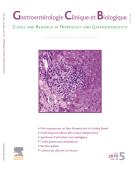Effect of a gluten-free diet on bone mineral density in children with celiac disease - 26/02/09

Summary |
Aim |
The aim of the study was to assess the evolution of bone mineral density (BMD) in children with celiac disease and to evaluate the effect of a gluten-free diet (GFD).
Methods |
Altogether, 44children (31girls and 13boys) were followed-up. BMD was measured by dual-energy X-ray absorptiometry of the lumbar spine (Hologic QDR 4500). Results are expressed as absolute values for BMD, and as Z scores for chronological age (BMD/CA) and bone age (BMD/BA). Patients were divided into two groups according to whether they followed a diet without (n=34) or with (n=10) gluten for at least 1 year. All patients were clinically free of symptoms at the end of the follow-up.
Results |
At inclusion, 26patients (59%) were delayed in bone age, 17children (38%) had a BMD/CA≤1 S.D. and six (13.6%) had a BMD/CA≤2 S.D., whereas nine children (20%) had a BMD/BA≤1 S.D. and three (6.8%) had a BMD/BA≤2 S.D. During the follow-up, the BMD increase was greater in the GFD group, as determined by the BMD/CA/year (+0.05±0.3 vs −0.34±0.4 S.D.; P<0.01) and BMD/BA/year (−0.02±0.4 vs −0.4±0.6 S.D.; P<0.05). The gain in BMD/BA was smaller in the GFD group because of their need to catch up in bone maturation.
Conclusion |
Celiac children not following a GFD show delays in both bone maturation and mineralization. This prospective study confirms the importance of maintaining a GFD in children with celiac disease until the end of skeletal mineralization even in asymptomatic patients following a non-restricted diet.
Il testo completo di questo articolo è disponibile in PDF.Résumé |
But |
Le but de l’étude était d’évaluer l’évolution de la densité minérale osseuse (DMO) chez l’enfant atteint de maladie cœliaque et d’analyser l’effet du régime d’exclusion du gluten (RSG).
Méthodes |
Quarante-quatre enfants (31filles et 13garçons) ont été suivis. La DMO a été mesurée par absorptiométrie au niveau du rachis lombaire (appareil Hologic QDR 4500). Les résultats étaient exprimés en valeurs absolues de DMO, en Z score pour l’âge chronologique (DMO/AC) et en Z score pour l’âge osseux (DMO/AO). Les patients ont été répartis en deux groupes selon le suivi du RSG : bon suivi (RSG+ ; n=34) vs absence ou mauvais suivi du RSG (RSG− ; n=10) après un minimum d’un an de recul évolutif. Tous les patients étaient asymptomatiques à la fin de la période d’étude.
Résultats |
À l’inclusion, 26patients (59 %) avaient un retard de maturation osseuse, 17enfants (38 %) avaient une DMO/AC≤1 DS et six (13,6 %) une DMO/AC≤2 DS, alors que seulement neuf enfants (20 %) avaient une DMO/AO≤1 DS et trois (6,8 %) une DMO/AO≤2 DS. Pendant la période d’étude la DMO a augmenté de façon plus importante dans le groupe RSG+, que le gain soit exprimé en DMO/AC/an (+0,05±0,3 versus −0,34±0,4 DS ; p<0,01) ou en DMO/AO/an (–0,02±0,4 versus −0,4±0,6 DS ; p<0,05). Le gain exprimé en DMO/AO était moins significatif en raison d’un rattrapage de maturation osseuse.
Conclusion |
Les enfants présentant une maladie cœliaque et ne suivant pas leur RSG ont un retard de maturation et de minéralisation osseuse. Cette étude prospective confirme l’importance de poursuivre le RSG jusqu’à la fin de la minéralisation osseuse même en l’absence de symptômes cliniques à l’arrêt du RSG.
Il testo completo di questo articolo è disponibile in PDF.Mappa
Vol 33 - N° 2
P. 109-114 - Febbraio 2009 Ritorno al numeroBenvenuto su EM|consulte, il riferimento dei professionisti della salute.

